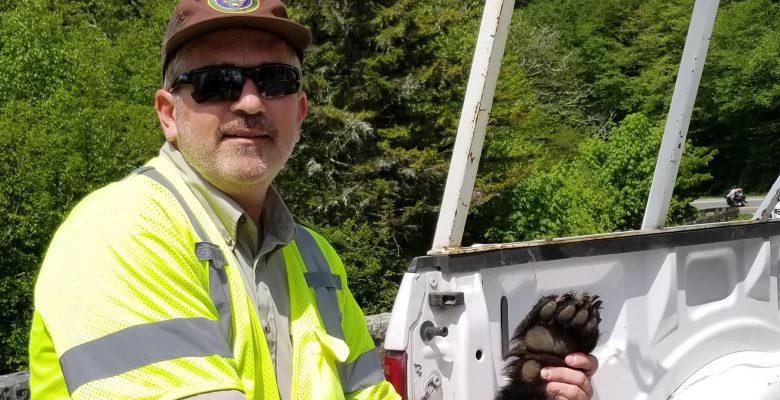Hands On With Smoky Mountain Bears
Black bears are an iconic symbol of Great Smoky Mountains National Park. Smoky Mountain bears are wild animals and thrive on a diet of nuts, berries, insects and animal carrion.
While volunteering for the National Park Service, I had the unique opportunity to go hands-on with a bear! Yes, the bear – actually three bears – were tranquilized and a wildlife biologist was carefully managing every detail of the interaction both for the safety of the bears and the safety of the people involved. It was a fun and educational experience to handle three Smoky Mountain bears.

What forced Great Smoky Mountains National Park to handle three bears? But first, these black bears are wild animals, potentially dangerous and should never even be approached. The National Park Service wildlife biologists are well educated, trained and experienced in safely conducting these types of activities.
Occasionally visitors to the Smoky Mountains leave trash at scenic pull-offs, along trails or in picnic areas. Bears have a keen sense of smell and are attracted to this unnatural food source.

Food Conditioned Smoky Mountain Bears
Smoky Mountain bears can become food conditioned. With increasing frequency, the bear will actually approach trash cans, picnic tables or even visitors in an attempt to get the high calorie human food. Sometimes visitors even toss chips, bread or donuts to either lure a bear within view, or perhaps even thinking they are helping by feeding a cute little cuddly animal.

Act as if what you do makes a difference. It does.
– William James, American philosopher and psychologist
Once a bear is food conditioned, its behavior becomes progressively more aggressive in search of the easy human food. Ultimately, it changes the behavior of the wild bears and they lose their fear of humans.

Gradually, the bear approaches closer and closer to people, attempts to enter vehicles, claws open coolers, and generally creates a negative experience. These negative interactions can unintentionally create very dangerous situations.
Feeding Smoky Mountain Bears
On Memorial Day Weekend, visitors were within a few feet of a sow (adult female bear) and two yearlings (last years’ cubs now just over a year old but still with their mother) tossing some high carb and sugar human snacks to them. Unfortunately, the yearlings were learning to interact with people to survive instead of foraging for insects, berries and nuts. By the way, feeding bears (or any wildlife) in a National Park is actually against the law and could potentially lead to law enforcement action.

So what to do with food conditioned bears? There are a multiple steps taken by the National Park Service to prevent food conditioning, such as: providing bear proof trash cans, educating visitors, thoroughly cleaning picnic areas every night, and partnering with local communities surrounding the park. If you live near Smoky Mountain bears, check out a community outreach program gaining traction: BearWise.org.
Handle and Release
With a goal of reinforcing their instinctual fear of humans, Smoky Mountain bears may be trapped, handled briefly and released. The bear is tranquilized and then a medical examine is conducted. Numbered ear tags may be applied for tracking purposes before the bear is released. Although harmless, this type of handling discourages bears from interacting with humans.

More specifics are in the captions below each photo. Also, I’ll have more coming in the next week or two on bears. In the meantime, if you see a bear, stay at a safe distance of at least fifty yards and do not feed any wildlife.
RVing Revealed
I’m always interested in your questions. Obviously, being in the Smokies I have garnered lots of information about bears. If you have questions or want me to post more about bears, feel free to connect with me to reach out via email or ping me on social media at these links:
In addition to more photos and information on bears, coming soon are also more details on my role as a volunteer with Great Smoky Mountains National Park.
As previously mentioned, I have no cell/internet service at the RV in the National Park, therefore please expect delays in my responses to texts, email, social media, etc.
